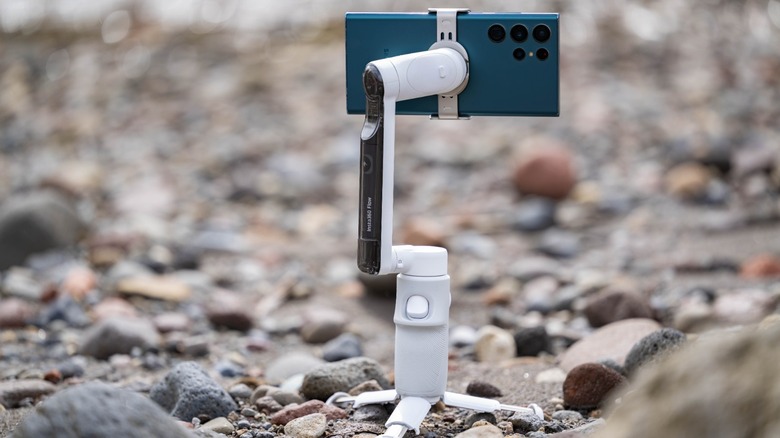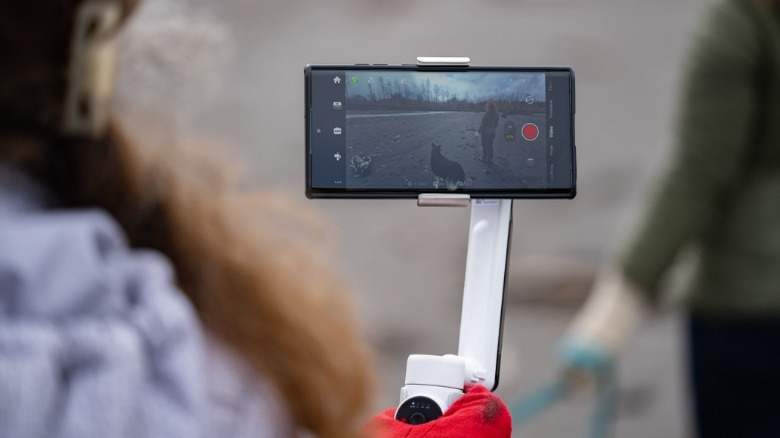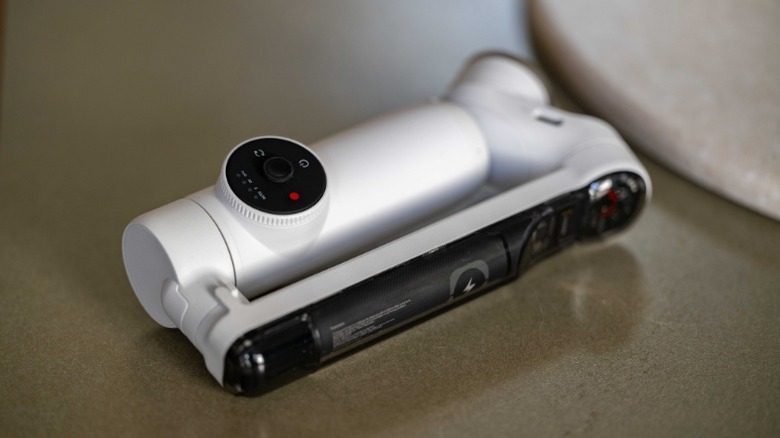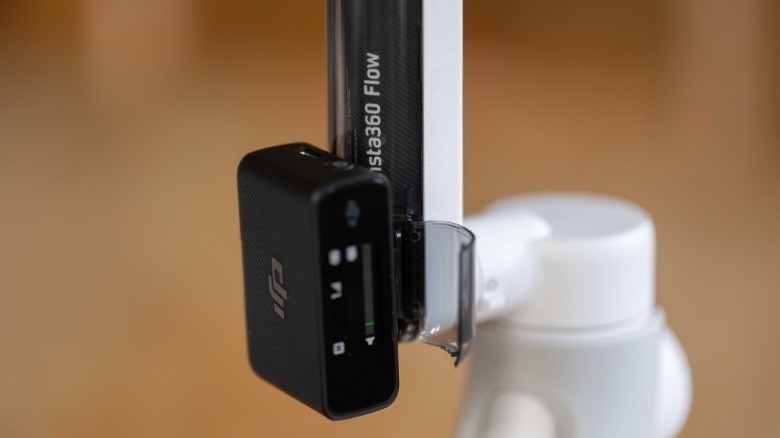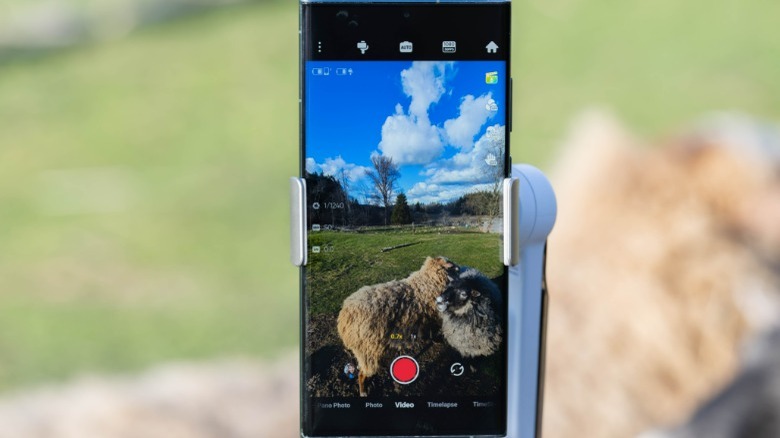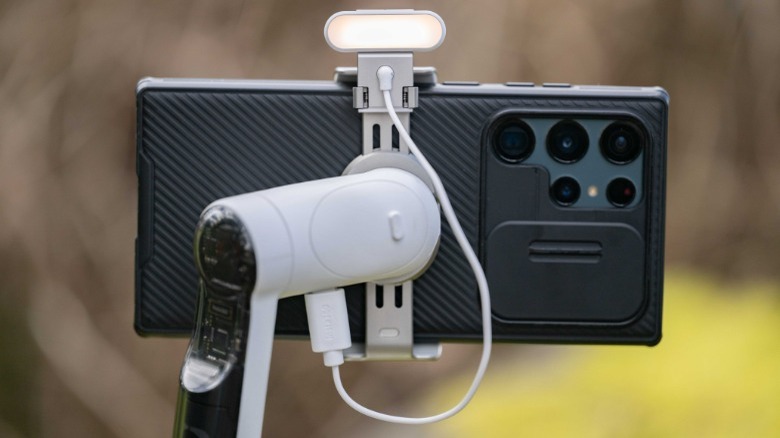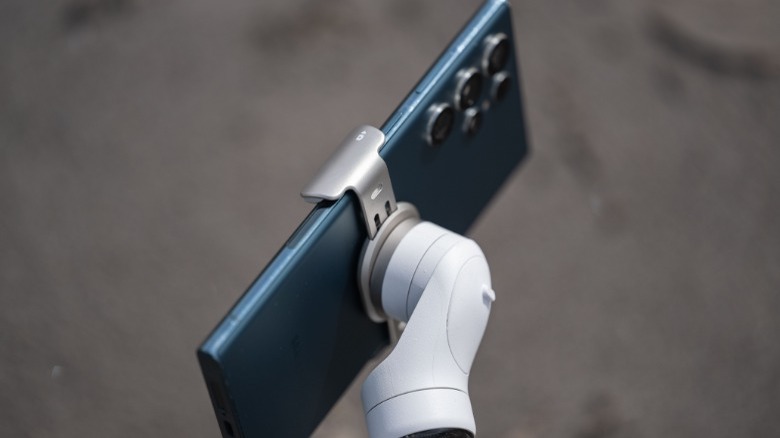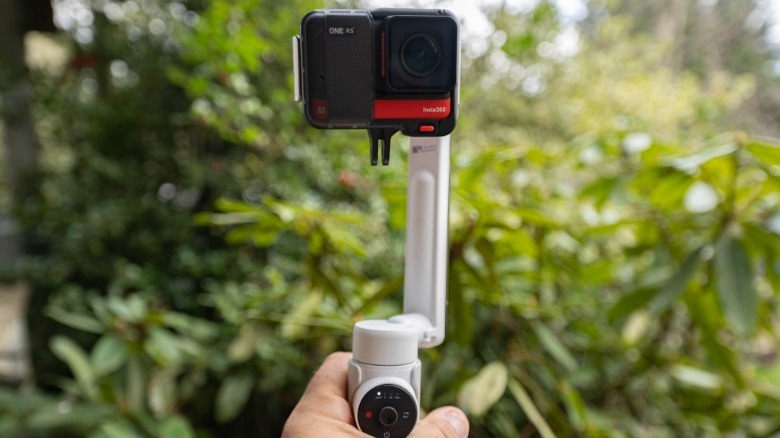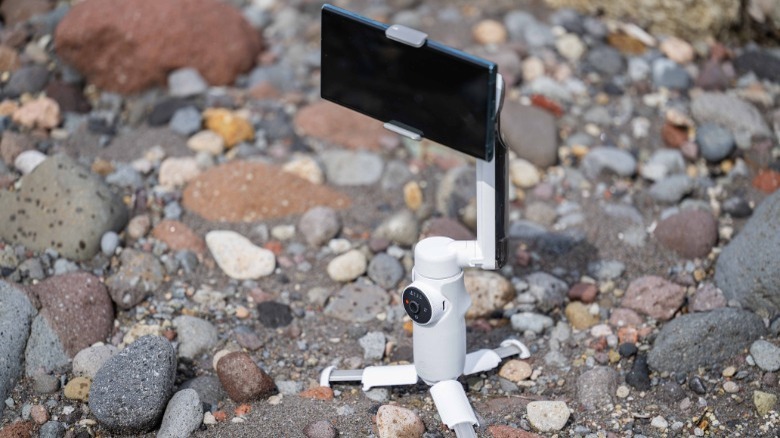Insta360 Flow Review: Streamlined Smartphone Gimbal
- Quick and easy startup
- Compact and portable
- Feature-rich companion app
- Good stabilization performance
- Excellent subject tracking
- Integrated tripod, selfie stick, and cold shoe mount
- App auto-launch is only available on IOS
- Mode switch wheel takes getting used to
- Limited tilt axis
Motorized gimbal stabilizers do a great job of smoothing out the bumps and judders that might otherwise foul your cinematic videography. Where large and powerful gimbals exist to stabilize large, professional cameras, smartphone gimbals bring super-smooth recording capability to the masses, and the Insta360 Flow is the latest and maybe the greatest of the latter category.
The Insta360 Flow aims to iron out the hassle typically associated with gimbals, making it an exciting prospect for anyone interested in picking up a gimbal stabilizer, but who's hesitant due to the steep learning curve typically associated with them. It also potentially offers significant benefits to veteran creators who could benefit from a more spontaneity-friendly smartphone stabilizer.
As someone who creates daily video content, minimizing the prep time associated with filming short-form content is essential. Whenever I'm out on a walk or running errands, I'm constantly looking for opportunities to film interesting clips to post as YouTube Shorts. I'm usually very limited on time when filming videos on occasions where photography and video creation aren't the primarily intended activity, so the idea of a simplified, portable gimbal that's quick to get up and running is quite exciting.
Insta360 provided me with a sample of the Flow for the sake of writing this review. I primarily tested it using the iPhone 12 Mini, as only the IOS app was available prior to launch, though post-launch I also was able to use the gimbal with the Samsung Galaxy S22 Ultra, which is my daily driver.
Easy to stow, quick to start
Perhaps the most compelling and notable aspect of the Flow is its streamlined startup and shutdown processes. The mounting clamp that holds the phone snaps onto the gimbal via a magnetic connection, meaning that you can leave it attached to your phone when not using the gimbal itself. This simple innovation shaves significant time and hassle from every opportunity you wish to capture with the aid of the Flow. A further innovation is that in order to turn on the flow, you need merely to twist the main arm of the gimbal upwards until it clicks in place and to turn it off you repeat the process in reverse.
The result of this streamlining of the gimbal setup process is a device with a much lower barrier to entry, and I find myself much more inclined to use the Flow than other gimbals I've used in the past. Furthermore, the Flow is remarkably good at balancing your phone and keeping it level, so there's no tedious fiddling with various levers and knobs to get it working. I only needed to adjust the leveling of the gimbal in the Insta360 app a few times during the time I spent testing the Flow.
Innovative and flexible design
The Flow's physical appearance is highly unusual. The long vertical arm of the gimbal is at odds with the tiny control grip, and the backside of the gimbal arm is translucent, revealing its interior components. The control wheel, buttons, and trigger are more conventional. Double-clicking the trigger recenters the gimbal; holding it down will lock the direction of the gimbal so that it doesn't deviate from the direction it's facing. A joystick enables manual directional control of the gimbal, while a multi-function dial controls functions such as zoom.
The touch-sensitive mode dial, which is used to swap between gimbal modes, is one of my few real gripes with the Flow. It takes practice to learn to reliably swap between auto, follow, pan follow, and first-person view (FPV). My instinct was to quickly swipe across the row of indicator lights, when in fact it's necessary to drag your finger around the whole touch-sensitive surface of the dial. Eventually, I developed the muscle memory to turn this into a non-issue, but it was frustrating at first. I would have much preferred a simple physical switch.
The other buttons on the control dial are fine. The power and record buttons are obvious in their function, while the third and final button swaps the camera view from front to selfie with a single press, switches the phone orientation from vertical to horizontal with a double press, and changes the mode from video to photo with a triple press.
Steady as she goes
It's important to set expectations with any gimbal. While they eliminate the worst of the bumps and jostles thrown their way, it nevertheless takes time to reliably capture perfectly smooth footage, and the Flow is no exception. Movement from walking or running will still be visible in the final video, albeit to a minimal degree. With that said, the Flow is definitely up to the standards of stabilization I've encountered in other gimbals, and delivers good results overall.
The somewhat outlandish way the flow is set up initially gave me the impression that it was mildly limited in terms of gimbal mobility. However, once I discovered that when the integrated selfie stick is extended the gimbal head can be manually articulated for a wider range of movement, this issue largely resolved itself. While it's true that the gimbal itself doesn't have as much vertical range as other, more traditional gimbals, the rotating head of the selfie stick negates this potential pitfall to a large extent. You can also hold the grip horizontally rather than vertically, which counters the issue even more effectively but is rather awkward.
Subject tracking is truly excellent with the feature "Deeptrack 3.0," being quick to activate and remarkably sticky so that it was consistently able to keep track of its target. It's amazing for vlogging and filming people or animals in general, though it will work with just about any subject you select.
Integrated tripod and cold shoe mount
The Flow features a built-in tripod, which extends from its handle, and while not particularly large or sturdy, it does allow the Flow to be set on a flat surface without having to carry an extra accessory. This also functions as a grip extender, which I very much appreciated, given my oversized hands. Pull up on the base of the gimbal to reveal an integrated selfie stick between the gimbal and the handle. This gives you a little extra reach and allows for further angular adjustment of the gimbal.
Additionally, a small hatch on the back of the gimbal arm pops open to reveal a cold shoe mount, which is ideal for attaching wireless lav mic receivers. This is a really nice feature if you want to use the Flow for vlogging, or for recording interviews and other content where a lav mic is advantageous. Potentially, you could also use this cold shoe to mount an extra LED light.
Excellent app integration
The Flow's companion app clearly shows the years of polish which have gone into refining Insta360's mobile software. I frequently use this app when working with the 360 cameras that Insta360 is most well known for, and the in-app experience for the Flow is every bit as good as what I've come to expect from the functionality the app offers with other cameras.
The app features built-in editing functions, integrated social features, and tutorials, in addition to camera and gimbal controls. When shooting with the app, you can access a wide variety of modes and settings. Modes include Pano Photo, Photo, Video, Timelapse, TimeShift, Widescreen Mode, Live Mode, and Hoop Mode. These are mostly self-explanatory in their function and are largely what you'd expect to find. The outlier is obviously the highly specialized Hoop Mode, which as the name implies is specifically designed to track basketballs.
A helpful feature for novice filmmakers is Shot Genie, which guides you through various different scenarios you might want to film with different types of shots. These range from suggesting ways to film hiking in the woods, to cooking, cats, and sports. There are also filters and film simulations, as well as AI-powered beauty-enhancing options.
The timelapse video capture mode of the Flow deserves special mention, as it offers both simple shooting options, and more advanced controls for recording time-lapses with cinematic motion. Thanks to the integrated tripod, it's an awesome all-in-one platform for capturing time-lapse videos.
Long lived battery, useful accessories, and a pocket sized profile
With a claimed 12-hour battery life, the Flow can go a long time without needing a recharge. All that juice has a greater purpose, however, as it is also capable of charging your smartphone as you're recording. Despite my frequent use of the Flow, I only had to recharge it once over a period of three weeks. It's somewhat incredible, given its diminutive profile, which is just 3.1 x 6.4 x 1.4 inches. The Flow is small enough that I found myself frequently carrying it with me in a large coat pocket.
Included with the Flow is a carrying case, which is just clear plastic with a magnetic clasp, but it comes with a neck strap, and is functional, as well as more durable than first impressions might imply. There are also cables for IOS and Android devices included, as well as a USB-C powered LED Spotlight which clamps onto the phone clip. This has a number of adjustable color options and is diffused so as to provide a soft, appealing light.
Minor compatibility issues and a workaround
On iPhone, the app launches automatically as soon as the gimbal is turned on, which is a feature I particularly appreciated once I switched to using an Android device, on which this functionality sadly isn't available. Other than that, the user experience is completely uniform between the two different platforms, though I must note that the app does not support the telephoto and super telephoto cameras of the Samsung Galaxy S22 Ultra.
However, since the gimbal functions even when the app isn't in use, it is possible to film with the other cameras using the phone's primary camera app. I was able to use the S22 Ultras 10x camera to film birds at a distance, and the result was as good as if I'd had the phone on a tripod. I was even able to capture some really nice footage of a distant hawk in flight by panning the gimbal to follow his path across the sky. It's a shot I would have otherwise thought impossible to pull off with a smartphone to obtain such a smooth result.
On beyond smartphones
While not officially supported by Insta360, the Flow does in fact function on a basic level with action cameras such as the GoPro Hero 11, DJI Osmo Action 3, or indeed Insta360's own One RS. You don't get any level of connectivity between the Flow and an action camera, which means you don't get all the extra features, like subject tracking, which you would access through the Insta360 app. Also, you've got to use the gimbal the wrong way round, which obscures the screen of the action camera and makes using the controls rather awkward, but it's nonetheless useable if you want to add a little extra stability when shooting video with a small camera that's roughly the width and weight of a smartphone.
The cool thing about using the Flow with an action camera is that when the already excellent electronic stabilization of a modern action camera is augmented by the Flow, the resulting footage is startlingly smooth. It needs to be stressed that this setup is by no means an intended use of the Flow, but I'm always happy to discover that a device is actually more useful than advertised.
Conclusion
The Flow may be Insta360's first gimbal, but you'd hardly be able to tell given the polish and innovation on display here. Despite a few minor stumbles, it easily holds its own against the likes of the Zhiyun Smooth 5 or the DJI Osmo Mobile 6. Its compact size and ease of use are its clear, primary advantages, with the various software features such as subject tracking and timelapse video recording also being compelling and robust.
You'll find prices in the official Insta360 store of $169 for the base model, and $209 for the Creator Kit which includes the Spotlight, carry bag, and additional cables, the Flow is roughly on par with other smartphone gimbal stabilizers in terms of cost, which is reasonable. It's remarkable for how quickly it's ready to shoot straight out of the box, with very little setup time required. There's a bit of a learning curve, particularly when it comes to the gimbal mode switch controls and overcoming the gimbal tilt limitations, but the initial barrier to entry is incredibly low. The Insta360 Flow is easy to recommend, and a worthy contender to established smartphone gimbal brands.
